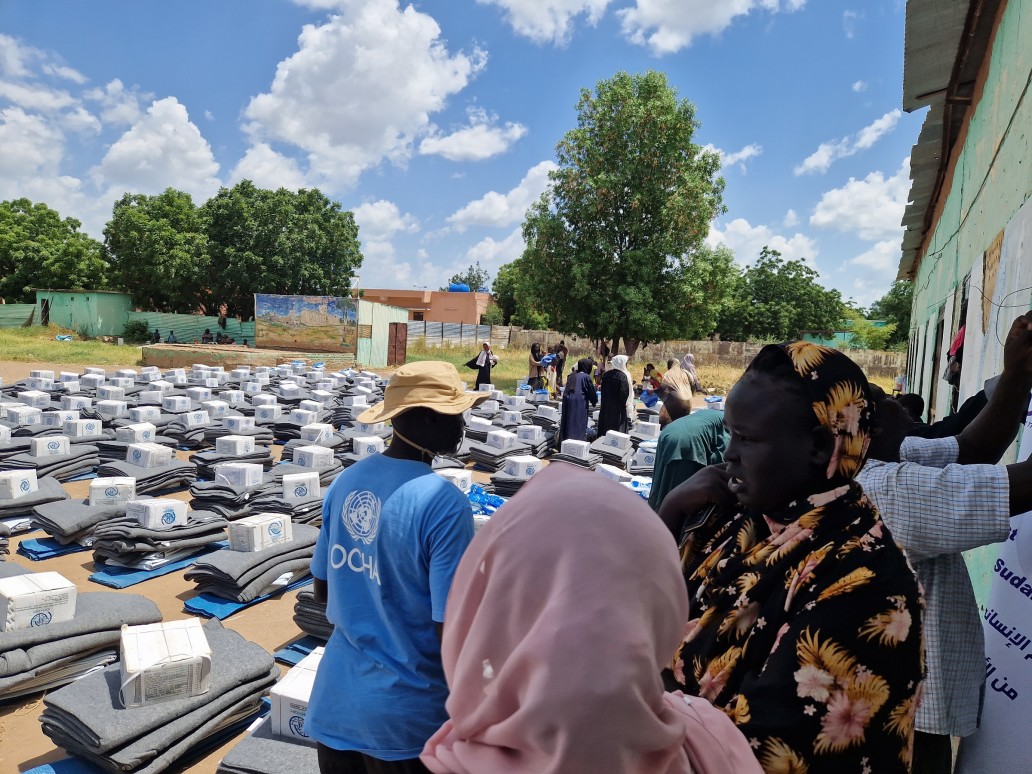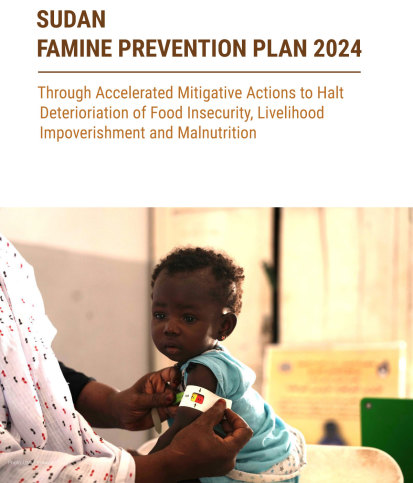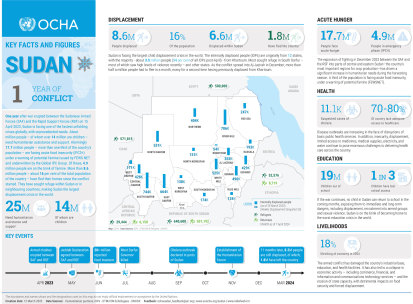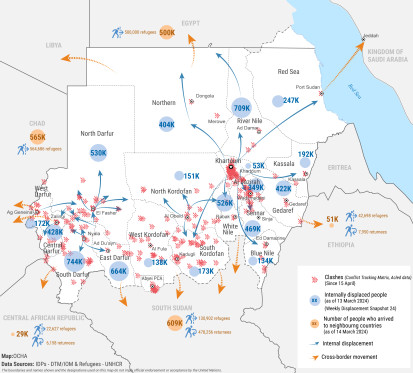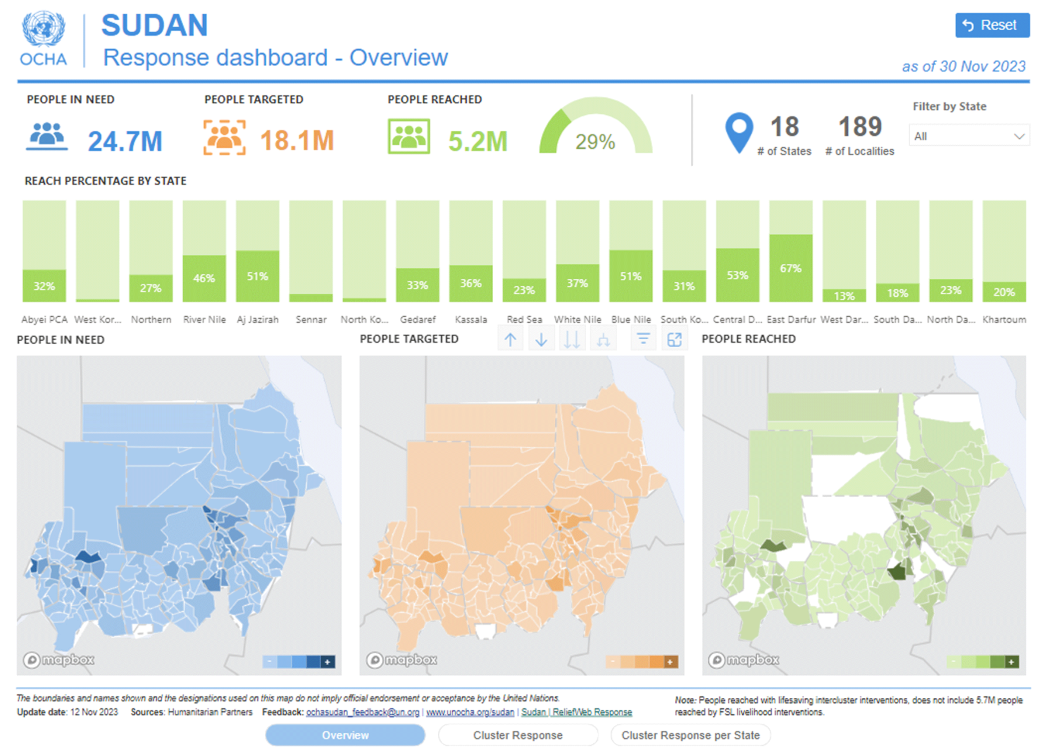SITUATION OVERVIEW
The number of people displaced by the conflict between the Sudan Armed Forces (SAF) and the Rapid Support Forces (RSF) continues to increase. About 6.5 million people have been displaced within Sudan since 15 April, according to the International Organization for Migration Displacement Tracking Matrix (IOM DTM) Sudan Weekly Displacement Snapshot (24). The number of internally displaced persons (IDPs) has increased by about 107,800 people over the past two weeks. The 6.5 million IDPs are in all of Sudan’s 18 states, with the highest proportions in South Darfur (11 per cent), River Nile (11 per cent), and East Darfur (10 per cent) states.
IOM DTM field teams reported that the IDPs were originally displaced from 12 states. About 55 per cent of them were displaced from Khartoum State, followed by South Darfur (15 per cent), North Darfur (9 per cent), Aj Jazirah (8 per cent), Central Darfur (4 per cent), West Darfur (4 per cent), and other states. In addition, about 1.96 million people crossed the border, IOM DTM reported. Of those who crossed the border about 1.76 million people arrived in neighbouring countries since 15 April, according to the UN Refugee Agency (UNHCR). This brings the total number of people displaced within and outside of Sudan since mid-April 2023 to 8.5 million.
Since 15 April, ACLED has recorded 14,790 reported fatalities in Sudan. This includes close to 800 reported fatalities from 10 February to 8 March 2024. Most I incidents of violence were recorded in Khartoum State over the past month, with more than 157 events and 238 reported fatalities reported. The most common event type was battles (with 140 recorded), followed by violence against civilians - 120 events. Compared to the previous four weeks, ACLED recorded a 30 per cent decrease in battles and an 89 per cent increase in violence against civilians. ACLED states that the reported number of fatalities in Sudan is a conservative estimate due to methodological limitations of real-time reporting in a fast-moving conflict context.
More civilian casualties and displacement in North Darfur
During the reporting period, at least five people were killed, another 15 injured and more than 250 people displaced in parts of North Darfur State as a result of clashes and airstrikes in Al Fasher town, Kebkabiya town, and Al Zurug village between 15 and 19 March, according to the International Organization for Migration Displacement Tracking Matrix (IOM DTM). Access to food remained the highest reported need among internally displaced communities as of 21 March 2024, followed by non-food items and access to livelihoods, according to the DTM Monthly Displacement Overview (07). There are about 530,000 IDPs in North Darfur who have been displaced after 15 April, according to the IOM DTM.
FEWS NET warns of a risk of famine in parts of West Darfur, Khartoum, and Greater Darfur
After 11 months of conflict between SAF and RSF, humanitarian needs in Sudan are reaching new highs and will steeply escalate during an atypically early start of the lean season in March through September 2024, FEWS NET reported in its Sudan Food Security Outlook for February to September 2024. Crisis levels of food insecurity (IPC Phase 3) are expected to be widespread, while Emergency levels (IPC Phase 4) are anticipated to expand significantly across Greater Darfur, Greater Kordofan, Khartoum, Red Sea, Kassala, and parts of the southeast of the country. Catastrophe (IPC Phase 5) levels of food insecurity are expected among households in parts of West Darfur, Khartoum, and among the displaced population more broadly, particularly in hard-to-reach areas of Greater Darfur, according to the FEWS NET.
Close to 230,000 children and new mothers likely to die from hunger without critical action
Nearly 230,000 children, pregnant women and new mothers could die in the coming months due to hunger unless urgent, life-saving funding is released to respond to the massive and worsening crisis in Sudan, Save the Children said on 13 March. More than 2.9 million children are acutely malnourished and an additional 729,000 children under five years are suffering from severe acute malnutrition – the most dangerous and deadly form of extreme hunger, according to new figures released by the Nutrition Cluster in Sudan. Of these children, more than 109,000 are likely to have medical complications like dehydration, hypothermia and hypoglycemia, which require intensive and specialized care at a hospital to survive. According to the Nutrition Cluster, about 222,000 severely malnourished children and more than 7,000 new mothers are likely to die in the coming months if their nutritional and health needs remain unmet.
About 24 million children are at risk of generational catastrophe – UN Committee on the Rights of the Child
About 24 million children in Sudan are at risk of generational catastrophe, the UN Committee on the Rights of the Child said on 18 March. Among these children, 14 million are in dire need of humanitarian support, 19 million are out of school, and 4 million are displaced, according to the UN Children’s Agency (UNICEF). This makes Sudan now the largest child displacement crisis in the world. The conditions are appalling, with acute shortages of food and clean drinking water; UNICEF found that 3.7 million children are acutely malnourished, including 730,000 with severe acute malnutrition. The Committee expressed deep concern over clear violations of children's rights to life, survival, education and development under international human rights law and international humanitarian law. The Committee urged Sudan to immediately take all urgent and necessary measures to end these severe violations and fulfil its commitments under the Convention on the Rights of the Child.
National cereal production is 40 per cent below the last five-year average – FAO
Sudan's national cereal production in 2023, including wheat crops to be harvested in March 2024, is estimated at 4.1 million tonnes, 46 per cent below the previous year's harvest and about 40 per cent below the previous five years, according to the Sudan 2023 Crop and Food Supply Assessment Mission (CFSAM) newly released by FAO. The significant decrease in total cereal production in 2023 was due to the impact of the ongoing conflict on agricultural operations through insecurity as well as the limited availability and high prices of agricultural inputs. An erratic spatial and temporal distribution of seasonal rains, with prolonged dry spells in southeastern key-producing areas, affected yields and contributed to reduced crop production. The high prices of agricultural inputs, caused by limited availability due to conflict-related reduced imports and disrupted internal trade flows, led to soaring costs of production.
Grain prices in conflict-affected areas double or triple of January 2023 levels – FEWS NET
Grain prices in key markets in parts of Sudan directly affected by conflict are up to double or triple compared to last year’s prices, according to the most recent Sudan Price Bulletin by FEWS NET. Sorghum prices in January 2024 almost tripled in Ag Geneina, West Darfur compared to January last year. The prices in Kadugli, South Kordofan were about 2.5 times higher, and they were about double in El Obeid, North Kordofan and Nyala, South Darfur. Sorghum prices in Al Fasher, North Darfur were about 50 per cent higher than last year. Wheat prices tripled in Omdurman, Khartoum State, and increased by 2.5 times in El Obeid, and doubled in Kadugli and Al Fasher. Millet prices more than doubled in El Obeid and Kadugli and doubled in Omdurman and Ag Geneina. In Al Fasher, millet prices increased by about 35 per cent in Al Fasher and in Nyala they increased by 25 per cent, according to FEWS NET. Sorghum, millet, and wheat are the most important food commodities in northern Sudan. Sorghum is the staple food for most poor households in central and eastern Sudan regions while millet is the main staple food for the majority of households in Darfur and some parts of Kordofan regions in western Sudan. Wheat i is a staple food for northern states, according to FEWS NET.
Federal Ministry of Health reports lower numbers of suspected cholera cases
The number of reported suspected cases of cholera across the country continues to decline because of intensive interventions by national health authorities, World Health Organization (WHO) and partners, the WHO Regional Director Hanan Balkhy said during her visit in Port Sudan. The number of suspected cholera cases reached about 11,000, including 305 associated deaths, reported from 60 localities of 11 states as of 20 March 2024, according to the Federal Ministry of Health (FMoH) and the WHO Sudan Outbreaks Dashboard. This is an increase of 164 cases or 1.5 per cent compared to 20 February. The overall trend in terms of the reported cases has been on a downward trajectory, with a much lower increase compared to previous months. Meanwhile, a joint vaccination campaign against cholera has successfully reached 4.5 million people across the country, according to the WHO. In addition, WHO supported 42 stabilization centres across Sudan in 2023 to treat children with medical symptoms of severe acute malnutrition. This has resulted in a 90 per cent cure rate among all children admitted, well above the international standard of 75 per cent. Even before the escalation of war in April 2023, Sudan was facing six concurrent disease outbreaks. In September 2023, the country announced a cholera outbreak, which eventually spread to 12 states. In the past few months alone, WHO’s efforts have resulted in a decline in the number of cases of cholera, dengue, and malaria. Over 500 surveillance officers trained by WHO across the country are working to ensure the early detection of these and other diseases.
Vaccination campaign against the emergence of new poliovirus in Red Sea State
The FMoH will launch a polio vaccination campaign in April 2024 in response to a new emergence of variant poliovirus type 2 reported in January 2024, WHO reported on 11 March. It was detected in six wastewater samples collected from September 2023 to January 2024 in Port Sudan locality, Red Sea State. FMoH, with support from the WHO, has completed field investigations and a risk assessment to determine the extent of the virus circulation. Preparations for a polio vaccination campaign in April 2024 in Red Sea, Kassala, Gedaref, River Nile, Northern, White Nile, Blue Nile and Sennar states are underway, with a differentiated approach for the rest of the states as conditions allow. This new detection comes 14 months after Sudan declared an outbreak of variant poliovirus type 2, from an unrelated emergence of the virus, which was detected in a 4-year-old child in West Darfur in October 2022.
More than 25 per cent of hospitals not working - WHO
Attacks on health care during the war have left more than 25 per cent of all hospitals nonfunctional and the main national laboratory in Khartoum is occupied by fighters, the WHO Regional Director Hanan Balkhy said during her visit to Port Sudan. WHO reports that 15 million people lack access to health care and between 70 – 80 per cent of health facilities are not functioning due to the ongoing conflict. In Port Sudan, health facilities are receiving between two and four times the number of patients they are used to managing. Despite various challenges, WHO and health cluster partners have supported the vaccination of 4.5 million against cholera over the past few months.
UNICEF-supported water plant in Omdurman providing water for 300,000 people
A UNICEF team that visited Omdurman in early March reported that the UNICEF-supported Al Manara water treatment plant, the only functioning plant out of 13 plants in the Khartoum area, is providing safe water to about 300,000 people in Omdurman. It has been damaged by the fighting and is working at just 75 per cent capacity but will cease to function in two weeks unless more chlorine to treat water can be brought in for that population, the UNICEF team warned. Hunger is pervasive in Khartoum and is a top need and concern for people, the team said. While there is food in the market, it is unaffordable for most families, due in part to a continued telecommunications blackout that is preventing families from receiving much needed mobile cash. The numbers of acutely malnourished children are rising. Nearly 3.7 million children are projected to be acutely malnourished this year in Sudan, including 730,000 who need lifesaving treatment, according to UNICEF.
HUMANITARIAN RESPONSE
Despite challenges facing humanitarian operations, humanitarians continue to deliver humanitarian assistance and provide services to vulnerable people across the country. Since 1 January 2024, 77 humanitarian partners reached more than 2.3 million people across Sudan with life-saving assistance, according to the Sudan Humanitarian Response Dashboard February 2024. This includes an estimated 1.3 million people who received food supplies and about 757,000 people who were reached with water, sanitation and hygiene services. In addition, about 389,000 people benefitted from health care, and about 154,000 people received emergency shelter and non-food supplies.
From 1 January to 29 February 2024, 12 health cluster partners provided about 388,048 out-patient consultations in 12 states, and about 275,300 people in 10 states received medicines, the health cluster in Sudan reported. In addition, 16 mobile clinics and seven ambulances were supported in Blue Nile, East Darfur, Gedaref, Kassala, North Darfur, Sennar, South Darfur, South Kordofan and West Darfur states. Close to 7,100 deliveries were assisted, including support for 166 c-sections followed by 9,300 postnatal care sessions.
Water, sanitation and hygiene (WASH) cluster partners had provided access to water to approximately 26,000 people, sanitation services to approximately 78,000 people, and hygiene interventions to approximately 643,000 people as of the end of February 2024, WASH cluster reported on 24 March. The conflict and the cholera/acute watery diarrhoea (AWD) outbreak prompted partners to prioritize hygiene and sanitation activities, such as handwashing and latrine disinfection, as well as water-related activities, particularly water trucking and drinking water treatment. Humanitarian Response Plan (HRP) partners' reporting gradually improved, and the sector began to accept reports from non-HRP partners.
HUMANITARIAN ACCESS
In a White Note submitted to the Security Council this month, the UN made recommendations on urgent steps to address the escalating food insecurity crisis in Sudan
These include:
Ensuring that the parties respect their obligations under international humanitarian law, including the prohibition of the use of starvation as a method of warfare and the protection of vital goods, infrastructure and services needed for food systems and production.
Ensuring that the parties commit to sustained humanitarian dialogue to facilitate crossline and cross-border humanitarian access.
Scaling up funding for the humanitarian operation, and
Pressing for an immediate ceasefire and a peaceful resolution to the conflict.
Addressing the Security Council on 20 March 2022, OCHA’s Director of Operations and Advocacy Division Edem Wosurnu said:
“In such a situation, the delivery of humanitarian aid should be a lifeline to the millions of people who have lost almost everything to the conflict. Let me zero in on humanitarians’ ability to access people in need at this time.
Regrettably, our ability to reach the most vulnerable, most notably in Khartoum, Darfur, Kordofan and Aj Jazirah States, continues to be severely obstructed.
Earlier this month, you adopted a resolution calling for full and unhindered humanitarian access in Sudan. Since then, I regret to report that there has not been major progress on the ground.
We do welcome that after revoking their agreement to the cross-border operation from Chad, the Sudanese authorities announced on 5 March alternative routes including temporary access via Tine crossing. The procedures for the use of this crossing are yet to be elaborated or put in place.
On 14 March, the Sudanese authorities informed us of their decision to allow the entry of 60 trucks through Adre, Chad into West Darfur. A convoy of trucks with assistance, including food for over 175,000 people, is being prepared and should be deployed in the coming two to three days.
These are positive steps, but they are far from enough in the face of looming famine.
At a minimum, identified entry points must be made operational as soon as possible and kept open for as long as they are needed – one-off arrangements are not sufficient.
We also need immediate approvals to facilitate the crossline movement of supplies from Port Sudan. We have not been able to cross conflict lines into parts of Khartoum since October 2023 due to insecurity and lack of timely approvals.
Finally, the parties must protect humanitarian staff and supplies. This is crucial to our ability to deliver lifesaving assistance and address this escalating hunger crisis.”
HUMANITARIAN FUNDING OVERVIEW
The 2024 Sudan Humanitarian Needs and Response Plan (HNRP) requires $2.7 billion to provide life-saving multi-cluster and protection assistance to 14.7 million people across Sudan in 2024. As of 25 March 2024, the appeal is 5 per cent funded, with $135.7 million received, according to the Financial Tracking Service.
The Sudan Humanitarian Fund (SHF) and the Central Emergency Fund (CERF) have allocated over the past months $66.5 million to address the food crisis in Sudan, targeting Darfur, Kordofan and Khartoum states. Early January, the Humanitarian Coordinator Clementine Nkweta-Salami requested a Rapid Response allocation to address the looming food crisis. The $15 million allocated by CERF was split between WFP and UNICEF to support the procurement and distribution of food and nutrition items. Subsequently, through area-based consultations, SHF programmed $31.5 million mainly for nutrition, health and agricultural support, complemented with cash and WASH interventions. SHF is reaching out to the relevant agencies and implementing partners to assure complementarity and maximize efficiency between the CERF and SHF interventions.
In March, these two allocations were followed by an Underfunded Emergency allocation by CERF of $20 million, providing funding to complement the food crisis response with health, WASH, S/NFI and agricultural interventions, while a quarter of the allocated funds targeted protection interventions. Implementation of the CERF Rapid Response allocation has commenced, while interventions for the other two allocations will start from mid-April onwards. By these moves, pooled funds have injected a substantial amount into the food response at the beginning of the lean season that usually last from May to September.
